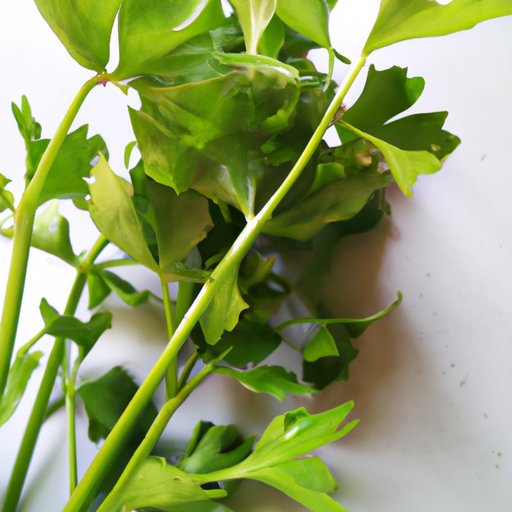
Introduction
When we think of celery, most people picture the crunchy, pale green stalks that are commonly used in salads and snacks. But did you know that the leaves of celery are also edible, and in fact, quite nutritious? In this article, we will explore the benefits of eating celery leaves, whether or not they are safe to consume, various ways to use them in cooking, and even some delicious recipes that showcase this underappreciated ingredient.
Surprising Benefits of Eating Celery Leaves: Why You Need to Add Them to Your Diet
Celery leaves are packed with nutrients, including vitamins A, C, and K, as well as potassium, calcium, and antioxidants like flavonoids and phenolic acids. These nutrients provide a range of health benefits, from reducing inflammation and supporting bone health to improving digestion and boosting immunity.
Interestingly, some of these benefits are even more pronounced in celery leaves than in the stalks. For example, the leaves contain more vitamin C and potassium than the stalks, as well as higher levels of certain antioxidants.
Are Celery Leaves Safe to Eat? Here’s What the Experts Say
While celery leaves are edible, some people may be hesitant to consume them due to concerns about safety or taste. However, according to experts, celery leaves are generally safe to eat and can even enhance the flavor of certain dishes.
That being said, it is important to wash the leaves thoroughly before eating them, as they may harbor bacteria or pesticides. Additionally, anyone with allergies or sensitivities to celery should avoid consuming the leaves as well.
Waste Not, Want Not: How to Use Celery Leaves in Your Cooking
One of the best things about celery leaves is that they are versatile and can be used in a variety of dishes. Here are a few ideas for incorporating them into your cooking:
- Use them as a garnish for soups, stews, or salads.
- Add them to smoothies or juices for an extra dose of nutrients.
- Chop them up and use them in place of parsley or cilantro in recipes.
- Make a pesto with celery leaves, garlic, olive oil, and nuts.
- Add them to omelettes, quiches, or frittatas for a fresh flavor.
Beyond the Stalk: 5 Delicious Ways to Use Celery Leaves in Your Recipes
If you’re looking for some specific recipe ideas that showcase the flavor and nutrition of celery leaves, here are a few to try:
- Celery leaf salad with lemon dressing and shaved parmesan
- Celery leaf and potato soup
- Grilled chicken with celery leaf chimichurri
- Celery leaf and apple smoothie
- Celery leaf tabbouleh with bulgur, tomatoes, and fresh herbs
From Appetizer to Dessert: 3 Recipes Putting Celery Leaves Center Stage
To really see how celery leaves can shine in a variety of dishes, here are a few more recipes that range from savory to sweet:
- Crispy celery leaf chips
- Celery leaf and feta stuffed chicken breasts
- Celery leaf and lemon sorbet
Celery Leaves vs. Celery Stalks: Which is More Nutritious and Why?
While both parts of the celery plant are nutritious and can be enjoyed in a variety of dishes, there are some differences in their nutrient profiles.
As mentioned before, celery leaves contain more vitamin C and potassium than the stalks, while the stalks have slightly more fiber and folate. However, both are low in calories and high in water content, making them a great option for hydration and weight management.
Conclusion
Whether you’re looking to add more nutrition to your diet, reduce food waste, or experiment with new flavors, celery leaves are an excellent ingredient to include in your cooking. Hopefully this article has given you some ideas and inspiration for incorporating this underutilized green into your meals.
Just remember to wash them thoroughly, be mindful of any allergies or sensitivities, and enjoy the many benefits that this often-overlooked part of the celery plant has to offer.





